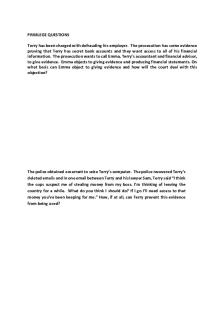SEFK questions PDF

| Title | SEFK questions |
|---|---|
| Author | belay woldu |
| Course | Introductory Biology: Cell And Developmental Biology |
| Institution | Cornell University |
| Pages | 2 |
| File Size | 74.5 KB |
| File Type | |
| Total Downloads | 97 |
| Total Views | 121 |
Summary
These are questions from a documentary we previewed...
Description
Sexual Encounters of the Floral Kind (1981) Recap questions
Ezedin Seid 1. What about the design of most flowers allows for self-fertilization to occur? - They have male and female reproductive organs within the same flower- they are bisexual. 2. What characteristic of a plant’s ‘lifestyle’ makes self-fertilization very adaptive (i.e., very advantageous)? - Because plants can not move around, they have adapt to varying conditions. 3. What is the function of stigma? What is the function of anther? - The stigma is a receptive organ- it receives the pollen grains, and the anther produces pollen. 4. Why might have pollination systems become so complex and elaborate? (i.e., Why have specificity in pollination systems?) - Specificity is important because it attracts certain species of pollinators. Different pollinators are lured towards different conditions, so it is crucial for the flower to mimic or provide that. 5. How has the hammer orchid (genus Drakaea) of the Australian bush evolved to attract wasp pollinators? - When the female wasps are underground, the orchid assumes the shape of the female wasp and even gives out the same scent to attract the male wasp. 6. Why could wind pollination be thought of as disadvantageous?
Sexual Encounters of the Floral Kind (1981) Recap questions - For wind pollination to succeed, the flower has to produce lots of pollen because the pollen doesn’t travel specifically to the right flower. So, there is quite a lot of pollen that goes to waste. 7. How do plants discourage nectar robbing (i.e., what are two mechanisms used)? - plants use indirect defenses like employing other insects to guard the flower, physical barriers, and use toxins. 8. Why is pollen desirable to a pollinator? - Pollen consists of necessary nutrients and minerals for the pollinator. 9. Protea is a South African genus of plant known for having large striking flowers. In some species the flowers are very exposed and point straight up, in other species the flowers are hidden and point straight down. How do pollinators differ between the two species of Protea? Due to their morphology, what animals do you think would pollinate them? - Animals that can not fly like mice and possum feed from the species of flowers pointing to the ground thereby facilitating pollination. On the other hand, different species of birds are attracted towards front facing flowers. 10. What two characteristics of the Arctic rose (Rosa acicularis) allow it to offer a “special reward” to its pollinators? Meaning- what benefit(s) do the pollinators receive for visiting the rose? - The pollinators receive nutrients and warmer spot- since the habitat is a low temperature area, warmer spots attract pollinators....
Similar Free PDFs

SEFK questions
- 2 Pages

Questions
- 10 Pages

Questions
- 88 Pages

Questions
- 1 Pages

Questions
- 46 Pages

Exam, questions
- 1 Pages

Sample Questions
- 3 Pages

Privilege Questions
- 1 Pages

Integration questions
- 7 Pages

Apple Questions
- 1 Pages

Defects Questions
- 2 Pages

Sephora questions
- 4 Pages
Popular Institutions
- Tinajero National High School - Annex
- Politeknik Caltex Riau
- Yokohama City University
- SGT University
- University of Al-Qadisiyah
- Divine Word College of Vigan
- Techniek College Rotterdam
- Universidade de Santiago
- Universiti Teknologi MARA Cawangan Johor Kampus Pasir Gudang
- Poltekkes Kemenkes Yogyakarta
- Baguio City National High School
- Colegio san marcos
- preparatoria uno
- Centro de Bachillerato Tecnológico Industrial y de Servicios No. 107
- Dalian Maritime University
- Quang Trung Secondary School
- Colegio Tecnológico en Informática
- Corporación Regional de Educación Superior
- Grupo CEDVA
- Dar Al Uloom University
- Centro de Estudios Preuniversitarios de la Universidad Nacional de Ingeniería
- 上智大学
- Aakash International School, Nuna Majara
- San Felipe Neri Catholic School
- Kang Chiao International School - New Taipei City
- Misamis Occidental National High School
- Institución Educativa Escuela Normal Juan Ladrilleros
- Kolehiyo ng Pantukan
- Batanes State College
- Instituto Continental
- Sekolah Menengah Kejuruan Kesehatan Kaltara (Tarakan)
- Colegio de La Inmaculada Concepcion - Cebu



